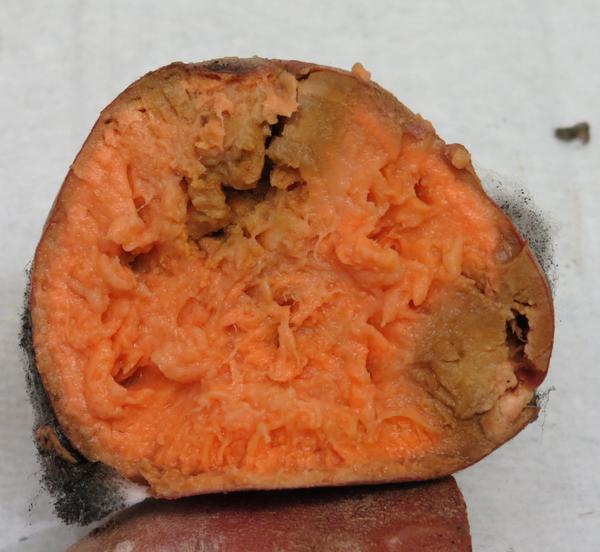Pathogen
Rhizopus soft rot is caused by the necrotrophic, Zygomycete fungus Rhizopus stolonifer.
Host Crops and Plants
R. stolonifer is a ubiquitous fungus that causes postharvest soft rot on more than 200 fruit and vegetable crops, most notably sweetpotato and stone-fruits.
Identification
Rhizopus soft rot typically appears during postharvest handling and transport and is rarely observed in the field. Symptoms originate at a wounded area in the sweetpotato and consist of a soft, watery rot that progresses quickly under favorable conditions and can result in full decay of an infected root in as little as three days (Figure 2). White to grey fungal mycelium producing black sporangia (Figure 1) of R. stolonifer are often observed growing on decayed roots, resembling a distinctive "grey man's beard." (Figure 3).
Favorable Conditions for Disease
R. stolonifer requires wounds in the sweetpotato root, particularly bruising wounds, for the disease to initiate. Disease progression and sporulation are then significantly influenced by storage conditions. While disease can occur over a broad range of temperatures, elevated temperatures of 25-29°C favor disease progression. Storage of sweetpotatoes at relative humidities between 75-100% seems to have little effect on disease progression, however higher humidities significantly increase sporulation of R. stolonifer, leading to increased secondary inoculum. Likewise, initial inoculum levels also have little impact on disease progression but do promote higher amounts of secondary inoculum.
Disease Transmission
R. stolonifer is a ubiquitous fungus, thus difficult to eliminate. Considering this is primarily a postharvest disease, it is often transmitted due to unsanitary harvest equipment, wash lines, packing equipment, and transportation containers.
General Disease Management
Prevention is the best method for control of Rhizopus soft rot and several steps can be taken to eliminate disease outbreaks:
- Reduce wounding during harvest, washing, and packing.
- Cure roots in a timely manner after harvest to allow for proper wound healing.
- Store sweetpotatoes at 85% humidity and 13°C with proper ventilation.
- Maintain sanitary harvesting, storage, washing, and packing equipment. Growers with established protocols to daily clean facilities and tools experience few problems with Rhizopus soft rot.
- Transport roots in sanitary containers.
- Eliminate infected roots from entering wash tanks and packing lines. Quickly remove discard bins or culls away from healthy roots in a way such that infected roots with sporulation are not exposed.
Disease Control for Conventional Growers
Traditionally, fungicides have been effective in the control of Rhizopus soft rot, however there are few labeled products of Rhizopus soft rot. For the latest fungicide recommendations for Rhizopus soft rot of sweetpotato see the Southeastern US Vegetable Crop Handbook. Fungicide labels are legal documents, always read and follow fungicide labels.
| Active Ingredient | Example Product | Application Rate |
|---|---|---|
| dicloran | Botran 75W | 1 lb product/100 gal |
| fludioxonil | Scholar 1.9SC | 16-32 oz product/100 gal |
Disease Control for Organic Growers
Two OMRI products are currently listed for control of Rhizopus soft rot on sweetpotato, but they show reduced efficacy compared to conventional fungicides. Proper sweetpotato handling and sanitation of equipment (see General Disease Management above) is essential for controlling Rhizopus soft rot in organic systems.
| Active Ingredient | Example Product | Application Rate |
|---|---|---|
| Pseudomonas syringae | Bio-Save 11LP | 250 g/40 gal |
| hydrogen peroxide | SaniDate 5.0 | 59.1-209.5 fl oz/1,000 gal |
Useful Resources
- The NC State University Plant Disease and Insect Clinic provides diagnostics and control recommendations
- The Extension Plant Pathology Portal provides information on crop disease management
- The Southeastern US Vegetable Crop Handbook provides information on vegetable disease management
- The USDA Fungus-Host Distributions Database provides information about reported hosts for fungal pathogens
Acknowledgements
This factsheet was prepared by the NC State University Vegetable Pathology Lab in 2015.
Publication date: April 13, 2018
Reviewed/Revised: Jan. 9, 2023
Recommendations for the use of agricultural chemicals are included in this publication as a convenience to the reader. The use of brand names and any mention or listing of commercial products or services in this publication does not imply endorsement by NC State University or N.C. A&T State University nor discrimination against similar products or services not mentioned. Individuals who use agricultural chemicals are responsible for ensuring that the intended use complies with current regulations and conforms to the product label. Be sure to obtain current information about usage regulations and examine a current product label before applying any chemical. For assistance, contact your local N.C. Cooperative Extension county center.
N.C. Cooperative Extension prohibits discrimination and harassment regardless of age, color, disability, family and marital status, gender identity, national origin, political beliefs, race, religion, sex (including pregnancy), sexual orientation and veteran status.



